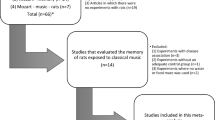Abstract
Protein synthesis inhibitors given during learning are known to disrupt memory in various animal species in several models of learning. However, there are suggestions that amnesia induced by protein synthesis inhibitors is not permanent-memory can be recovered by a reminder procedure, i.e., by presenting the animal with one of the components of the external environment which was part of the learning situation. The aim of the present work was to determine the existence of the reminder phenomenon in a well-studied model of single-session training to passive avoidance in chicks. Cycloheximide and anisomycin were used to induce amnesia. Reminder was performed using the aversive taste of methylanthranilate 24 h afte training, and testing was conducted 48 h after training. The results obtained provide evidence that memory disrupted by protein synthesis inhibitors in chicks can be recovered by the reminder procedure.
Similar content being viewed by others
References
P. K. Anokhin, “Foreword,” in: K. V. Sudakov, Biological Motivation, Meditsina, Moscow (1971).
P. K. Anokhin, “Systems analysis of integrative neuron activity,” Usp. Fiziol. Nauk,5, 5–92 (1974).
K. V. Anokhin, “Molecular scenarios for the consolidation of long-term memory,” Zh. Vyssh. Nerv. Deyat.,47, 262–286 (1997).
I. P. Ashmarin, “Molecular mechanisms of neurological memory,” in: Mechanisms of Memory [in Russian], G. A. Vartanyan (responsible editor), Nauka, Leningrad (1987).
R. I. Kruglikov, “On the reminder phenomenon,” Zh. Vyssh. Nerv. Deyat.,21, 419–422 (1971).
R. I. Kruglikov, “The neurochemical mechanisms of memory,” in: Mechanisms of Memory [in Russian], G. A. Vartanyan (responsible editor), Nauka, Leningrad (1987).
C. M. Alberini, M. Ghirardi, Y. Y. Huang, P. V. Nguyen, and E. R. Kandel, “A molecular switch for the consolidation of long-term memory: cAMP-inducible gene expression,” Ann. N.Y. Acad. Sci.,758, 261–286 (1995).
R. J. Andrew, “Drug administration,” in: Behavioural and Neural Plasticity: the Use of the Domestic Chick as a Model, R. J. Andrew (ed.), Oxford University Press, Oxford (1991).
R. Burchuladze and S. P. R. Rose, “Memory formation in day-old chicks requires NMDA but not a non-NMDA glutamate receptors,” Eur. J. Neurosci.,4, 1–5 (1992).
A. Cherkin, “Kinetics of memory consolidation: role of amnestic treatment parameters,” Proc. N.Y. Acad. Sci.,63, 1094–1101 (1969).
A. Cherkin, “Retrograde amnesia in the chick: resistance to the reminder effect,” Physiol. Behav.,8, 949–955 (1972).
A. Cherkin and M. W. Garman, “Ontogeny of the peck response in chicks: age dependence and target dependence,” Behav. Biol.,21, 128–133 (1977).
H. P. Davis and L. R. Squire, “Protein synthesis and memory: a review,” Psychol. Bull.,96, 518–559 (1984).
J. DeZazzo and T. Tulli, “Dissection of memory formation: from behavioral pharmacology to molecular genetics,” Trends Neurosci.,18, 212–218 (1995).
M. Dragunow, “A role for immediate-early transcription factors in learning and memory,” Behav. Genetics,26, 293–299 (1996).
P. Goelet, V. F. Castellucci, S. Schacher, and E. R. Kandel, “The long and the short of long-term memory—a molecular framework,” Nature,322, 419–422 (1986).
C. Holscher and S. P. R. Rose, “Inhibiting protein synthesis of the putative retrograde messenger nitric oxide results in amnesia in a passive avoidance task in chick,” Brain,619, 189–194 (1993).
R. Jork, G. Grecksch, and H. Matthies, “Impairment of hippocampal glycoprotein fucosylation—consequences on memory function,” in: Learning and Memory Mechanisms of Information Storage in the Nervous System, H. Matthies (ed.), Pergamon Press, Oxford (1986).
L. Landmesser, “Synaptic plasticity. Fastening synapses by adhesion,” Current Biol.,7, 28–30 (1997).
D. J. Lewis, J. R. Misanin, and R. R. Miller, “Recovery of memory following amnesia,” Nature,220, 704–705 (1968).
H. Matthies, “In search of cellular mechanisms of memory,” Prog. Neurobiology,32, 277–349 (1989).
R. Mileusnic, K. Anokhin, and S. P. R. Rose, “Antisense oligodeoxynucleotides toc-fos are amnestic for passive avoidance in the chick,” Neuroreport,7, 1268–1272 (1996).
K. T. Ng and M. E. Gibbs, “Studies in memory formation: a review,” in: Behavioural and Neural Plasticity: the Use of the Domestic Chick as a Model, R. J. Andrew (ed.), Oxford University Press, Oxford (1991).
T. A. Patterson, M. C. Alvarado, I. T. Warner, E. L. Bennett, and M. R. Rosenzweig, “Memory stages and brain asymmetry in chick learning,” Behav. Neurosci.,100, 856–865 (1986).
D. Quartermain, B. S. McEwen, and E. C. Azmitia, “Amnesia produced by electroconvulsive shock or cycloheximide: conditions for recovery,” Science,169, 683–686 (1970).
D. Quartermain, B. S. McEwen, and E. C. Azmitia, “Recovery of memory following amnesia in the rat and mouse,” J. Comp. Physiol. Psych.,79, 360–370 (1972).
S. P. R. Rose, “How chicks make memories: the cellular cascade fromc-fos to dendritic remodeling,” Trends Neurosci.,14, 390–397 (1991).
S. P. R. Rose, “Biochemical mechanisms involved in memory formation in the chick,” in: Behavioural and Neural Plasticity: the Use of the Domestic Chick as a Model, R. J. Andrew (Ed.), Oxford University Press, Oxford (1991).
S. P. R. Rose, “Cell adhesion molecules and the transition from short- to long-term memory,” J. Physiol. (Paris),90, 387–391 (1996).
P. A. Serrano, W. A. Rodriguez, E. L. Bennett, and M. R. Rosenzweig, “Protein kinase inhibitors disrupt memory formation in two chick brain regions,” Pharmacol. Biochem. Behav.,52, 547–554 (1993).
R. J. Steel and M. G. Stewart, “7-Chlorokynurenate, an antagonist of the glycine binding site on the NMDA receptor, inhibits memory formation in day old chicks (Gallus domesticus),” Behav. Neural Biol.,60, 89–92 (1993).
W. Zhao, P. Bennet, G. L. Sedman, and K. T. Ng, “The impairment of long-term memory formation by the phosphatase inhibitor okadaic acid,” Brain Res. Bull.,36, 557–561 (1995).
L. Squire and P. Alvarez. “Retrograde amnesia and memory consolidation: a neurobiologicla perspective,” Current Opinion in Neurobiol.,5, 169–177 (1995).
S. Zinkin and A. J. Miller, “Recovery of memory after amnesia induced by electroconvulsive shock,” Science,155, 102–104 (1967).
Author information
Authors and Affiliations
Additional information
Translated from Rossiiskii Fiziologicheskii Zhurnal imeni I. M. Sechenova, Vol. 83, No. 11-12, pp. 11–18, November–December, 1997.
Rights and permissions
About this article
Cite this article
Radyushkin, K.A., Anokhin, K.V. Recovery of memory in chicks after disruption during learning: The reversibility of amnesia induced by protein synthesis inhibitors. Neurosci Behav Physiol 29, 31–36 (1999). https://doi.org/10.1007/BF02461355
Received:
Issue Date:
DOI: https://doi.org/10.1007/BF02461355




